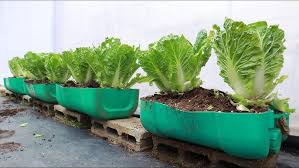Grow Napa Cabbage Without a Garden: A Sustainable Solution for Small Spaces
Napa cabbage, also called Chinese or Peking cabbage, is a versatile leafy vegetable with a mild, slightly sweet taste. It’s a staple in many Asian dishes, including stir-fries, salads, and the famous Korean kimchi. Contrary to the belief that you need a large outdoor garden to grow it, Napa cabbage can thrive in small spaces using simple plastic bottles. Here’s a step-by-step guide to growing Napa cabbage in 5-liter (or larger) plastic bottles, perfect for urban gardening or households with limited space.
Why Use Plastic Bottles to Grow Napa Cabbage?
- Maximize Space: Vertical gardening with plastic bottles is ideal for small balconies, windowsills, or compact outdoor spaces.
- Cost-Effective: Repurposing plastic bottles eliminates the need for expensive pots or planters.
- Eco-Friendly: Upcycle plastic waste while reducing your environmental footprint.
- Ease of Use: Lightweight and portable, bottle planters can be easily moved to ensure optimal sunlight exposure.
Materials You’ll Need
- 5-liter or larger plastic bottles (clear or translucent preferred)
- Potting soil or a nutrient-rich potting mix
- Napa cabbage seeds or seedlings
- Scissors or a utility knife
- Marker for labeling
- Watering can or spray bottle
- Optional: Liquid fertilizer
- A sunny spot or grow light

Step-by-Step Guide to Growing Napa Cabbage
- Prepare the Bottles
- Clean the plastic bottles thoroughly and remove any labels.
- Use scissors or a knife to cut off the top third of the bottle, leaving the bottom part intact for planting.
- Create Drainage
- Poke small holes at the base of the bottle to allow excess water to drain, preventing root rot.
- Add Soil
- Fill the bottle with potting soil or a suitable mix, leaving about 1-2 inches of space at the top.
- Plant the Seeds or Seedlings
- Sow Napa cabbage seeds or transplant seedlings, maintaining proper spacing as indicated on the seed packet.
- Label Your Planter
- Write the planting date and cabbage variety on the bottle for easy reference.
- Water Consistently
- Keep the soil evenly moist but avoid overwatering. Use a watering can or spray bottle to minimize disturbance to young plants.
- Provide Sunlight
- Place the bottles in a sunny spot where the cabbage can receive 6-8 hours of direct sunlight daily. If sunlight is limited, use a grow light.
- Care and Maintenance
- Monitor soil moisture and water as needed.
- Apply diluted liquid fertilizer once a month to support healthy growth.
- Harvest Time
- In 70-80 days, your Napa cabbage should be ready to harvest. Cut the head at the base when it reaches the desired size.
Conclusion
Growing Napa cabbage in plastic bottles is an innovative, eco-friendly way to enjoy fresh, homegrown produce without a traditional garden. This simple method not only yields nutritious vegetables but also helps reduce plastic waste by upcycling bottles. With regular care and attention to sunlight, water, and nutrients, you’ll be able to harvest delicious, homegrown Napa cabbage from even the smallest of spaces. Happy gardening!
This version is concise, informative, and engaging while ensuring readers walk away feeling empowered to try this sustainable gardening technique.
